Golden Laced Wyandotte: Breed Profile
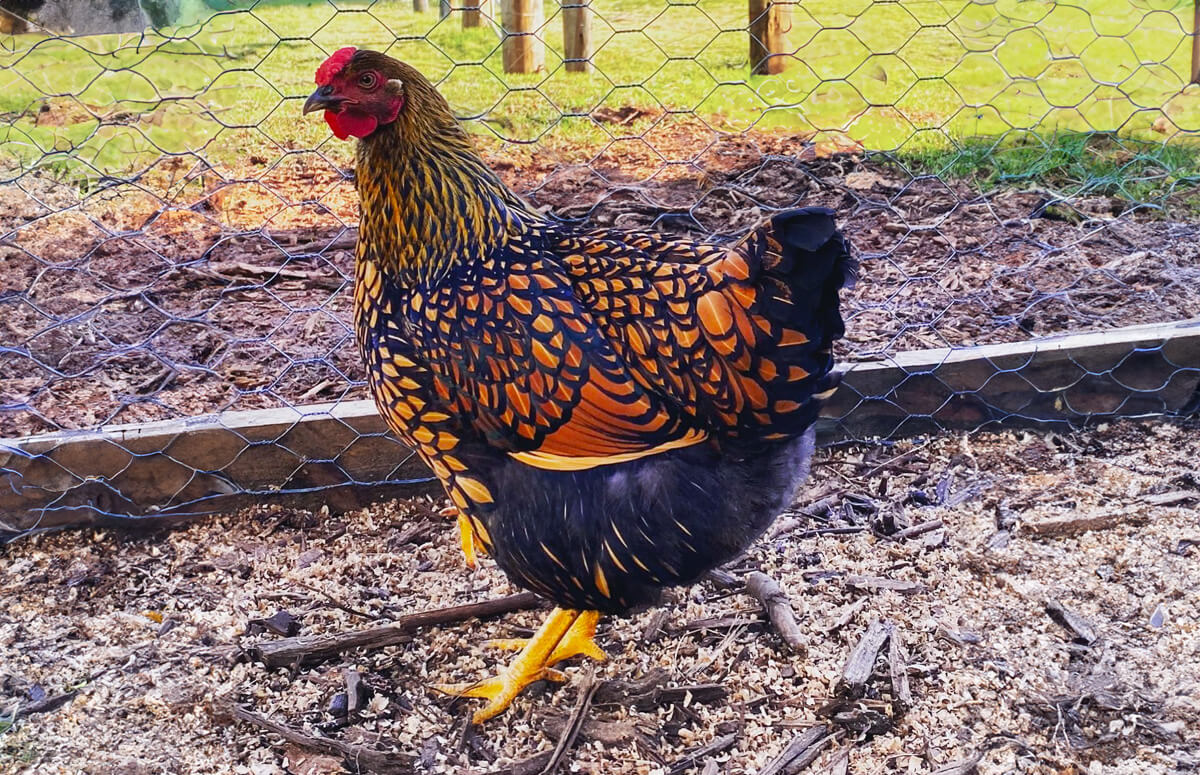
The Golden Laced Wyandotte is a stunning American chicken breed with a large round body and a scalloped pattern of gold with black lacing. They are gorgeous, hardy, docile, and pretty decent egg layers.
We’ll take a closer look into the Golden Laced Wyandotte’s (GLW) characteristics and its colors, and learn all about its personality and egg-laying skills. Here are some key takeaways:
| Eggs | 200 eggs/year |
| Egg Color | Brown |
| Egg Size | Large |
| Weight | 6.5 – 8 lbs |
| Hardiness | Cold |
| Temperament | Friendly but assertive |
| Beginner-friendly | Yes |
| Color | Golden Laced |
Characteristics
What makes the Golden Laced Wyandotte stand out is undoubtedly its striking colors. The deep black lacing around the golden brown feathers creates a special contrast, giving the chicken an almost royal appearance.
Like all other Wyandotte chickens, the Golden Laced version has a rather large and robust body. Golden Laced Roosters weigh around 8 pounds (3,6kg), and Golden Laced hens tip the scale around 6.5 pounds (2,9kg).
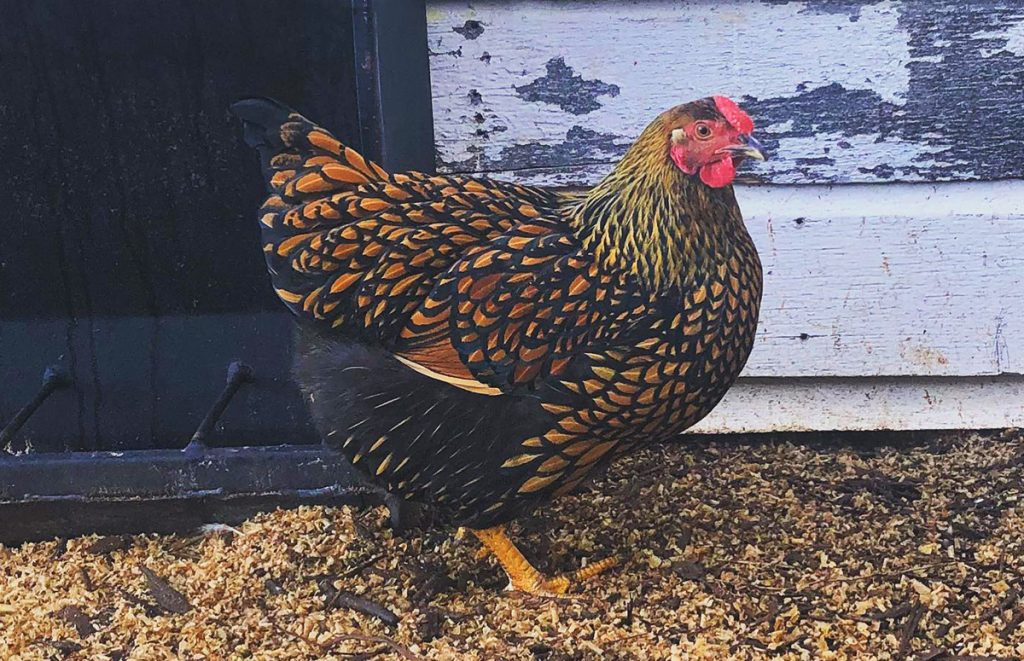
Golden Laced Wyandottes carry a rose comb, while their clean appearance and yellow skin characterize their legs. Their wattles, earlobes, and faces are red. These chickens have dark golden beaks and eyes that are distinctly yellow.
In line with the Wyandotte breed’s general characteristics, they have plump and rounded breasts, making them well-suited for meat production next to their impressive egg-laying abilities.
Eggs
The Golden Laced Wyandotte chicken is a versatile breed valued for its meat and egg production. The hens typically produce around four large eggs per week, or more than 200 eggs each year. Their eggs are brown.
During the winter months, their egg production will decrease or cease altogether. However, when provided with some extra lighting, these cold-resistant chickens tend to maintain their egg-laying activities. The only exception to their consistent laying is during molting.
It’s worth noting that Golden Laced Wyandotte hens can easily become broody, which will interrupt their egg production.
Pros and Cons
The Golden Laced Wyandotte is a breed cherished by many chicken keepers, but it comes with its own set of pros and cons. Let’s address the most important advantages and disadvantages.
On the positive side, these chickens do great in cold climates. Their small rose combs and fluffy bodies make them remarkably resilient to chilly temperatures. Additionally, their unique golden-brown and black laced plumage add an amazing touch to any flock. This dual-purpose breed, known for both egg production and meat quality, makes them a wanted breed with many homesteaders living self-sufficient lives. Wyandottes are also excellent foragers, reducing the need for extra feeding.
However, this also means they need more space than most other breeds. Next to that, despite their cold-hardy nature they do not fare well in warmer climates. Additionally, Golden Laced Wyandottes are a dominant breed, which can result in conflicts if you keep a mixed flock. It’s best not to keep them together with submissive breeds like Silkies or Faverolles.
Pros
- Cold-hardy
- Excellent foragers
- Dual purpose breed
- Beautiful colors
- Don’t need much extra care
Cons
- Need more space
- Dominant breed
- Don’t do well in warm climates
Golden Laced Wyandotte Hen Vs Rooster
| Feature | Golden Laced Rooster | Golden Laced Hen |
|---|---|---|
| Weight | 8 lbs | 6.5 lbs |
| Back | Pointed saddle feathers | Rounded feathers |
| Plumage | Patchy (cockerels) | Uniform lacing (pullets) |
| Tail Feathers | Long sickles, pointed, no lacing | Laced, shorter, rounded on the edges |
| Tail Coverts | Black with green luster | Black with a brown center in each feather |
| Comb, Wattles | Big, red | Small, pink |
| Body | Large and broad with long legs | Smaller, shorter legs |
Both male and female Golden Laced Wyandottes show the iconic golden-brown and black laced feather pattern. They also feature common characteristics like the golden-brown head, deep slate underfeathers, black downy plumage, and a gleaming green glow in their back plumage sections.
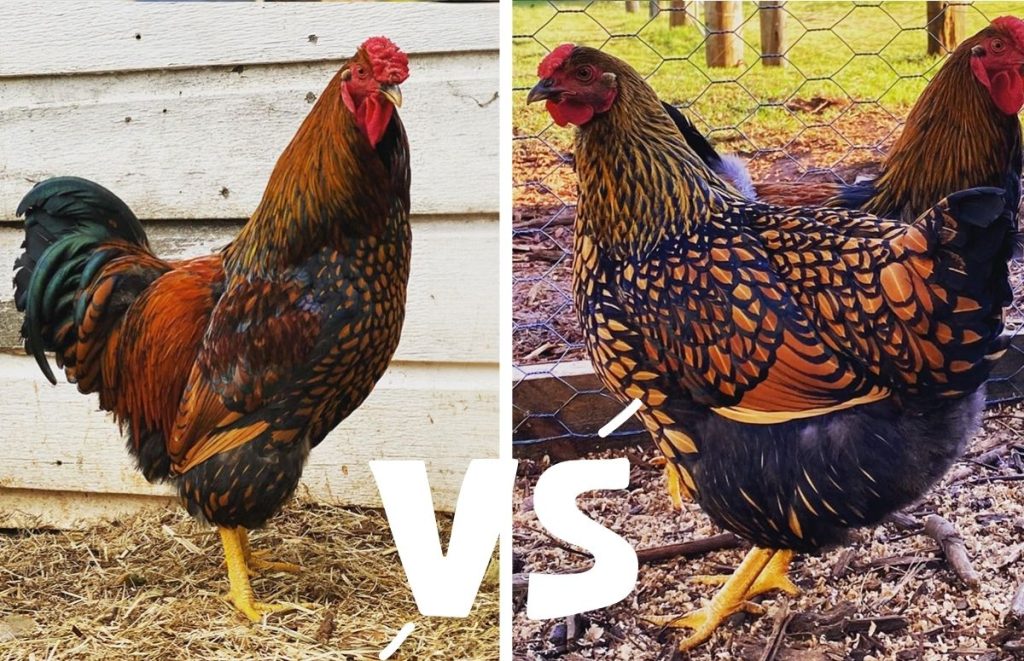
Sexing young birds for their gender can be somewhat tricky. Roosters tend to grow faster and develop slightly more pronounced and reddish wattles and combs, while those of hens are more pink. Also, roosters typically have a sturdier build and longer legs than their female counterparts.
Golden Laced Roosters have a shine on their shoulder coverts, and the contrast with the brown primary flight feathers and the green luster in the tail sickles is just magnificent when they open their wings.
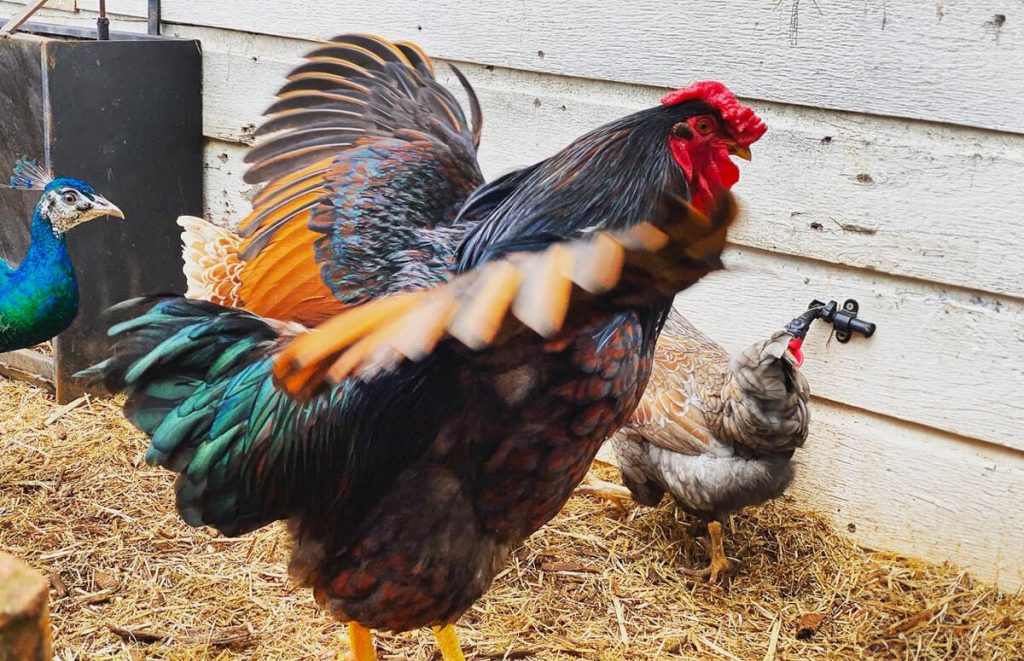
The lacing pattern and feathers will tell you more once the bird matures. The roosters have pointed saddle feathers and lack lacing on the tail feathers, as you can see in the photo above. Roosters feature black tail coverts with a distinct green luster. In contrast, the hens have black tails with coverts that display a mixture of black and brown.
You can tell their gender with certainty around the age of five months. If you want to learn more about the different kinds of feathers, check out our feather guide.
Golden Laced Wyandotte Chicks
Golden Laced Wyandotte chicks show a range of down patterns. Some are almost black, while others are golden brown. Most of these chicks bear lighter stripes along their backs.
Here is what the hatchlings look like when they get out of the eggs. The dark ones are the Golden Laced Wyandottes.
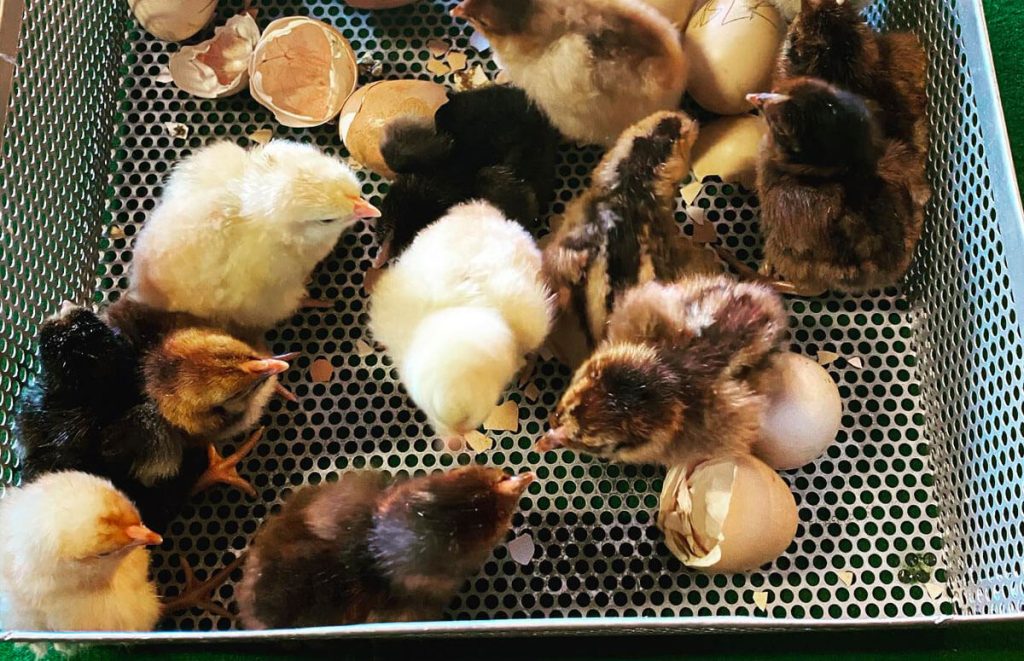
Upon hatching, their yellow shanks and beaks are immediately noticeable. The down of Golden Laced Wyandotte chicks may also feature hints of yellow around the eyes.
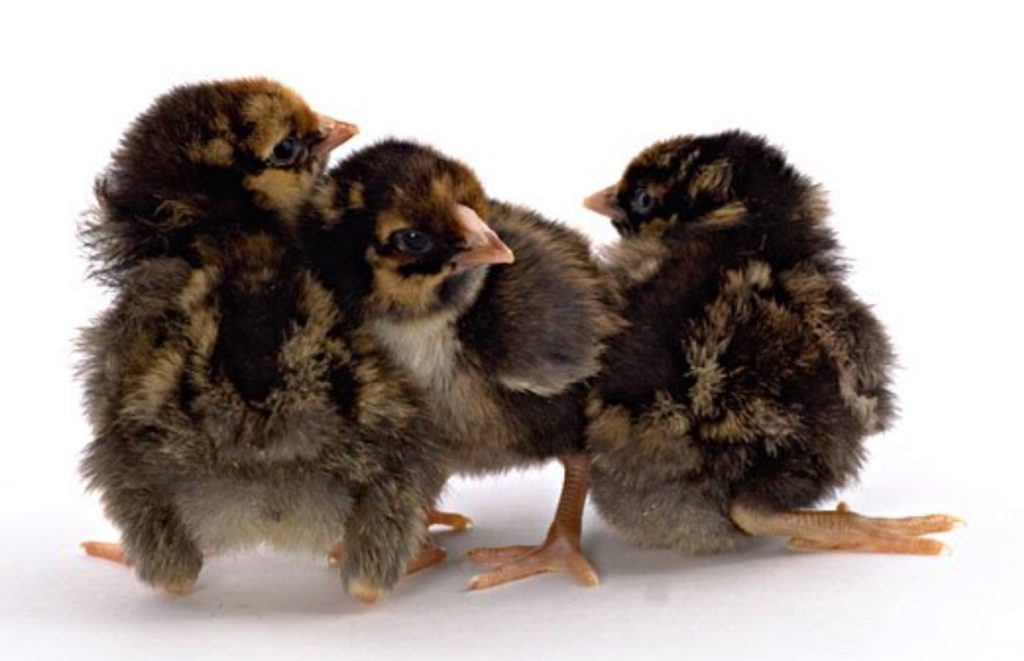
Golden Laced Wyandotte chicks are not sex-linked, so their gender cannot be determined immediately after hatching. Identifying their gender typically takes a couple of months. The cockerels’ plumage is a bit more patchy when they grow up, while the pullets usually show a rather uniform pattern.
In general, Wyandotte hens are known for their excellent mothering instincts, making them excellent caretakers for their chicks.
Climate
Wyandottes have especially been bred to survive cold American winters. Their small rose combs and plump bodies are useful adaptations that enable them to endure freezing conditions and prevent frostbite.
Nonetheless, these chickens aren’t penguins, either. Their combs and wattles are still susceptible to frostbite in extremely cold weather.
While they can bear some cold, Golden Laced Wyandottes do not like warm temperatures. They are not the best birds to keep when you are living in a warm or tropical climate. They can quickly overheat and suffer from heat stress.
The Golden Laced Color Variety
The Wyandotte chicken breed has many color varieties, and the Golden Laced variety (also called Gold Laced) is among the most popular ones. While only ten official Wyandotte color varieties are described in The Standard of the American Poultry Association, the Europeans have thirty colors listed.
In general, Wyandottes come in three classes:
- Laced Wyandottes: silver laced, golden laced, blue laced, …
- Marked Wyandottes: black-white Columbia, Silver Pencilled, …
- Single-colored Wyandottes: black, white, blue, buff, …
The Golden Laced Wyandotte has a golden plumage with beautiful black lacing. The roosters are more brownish, while the hens exhibit a redder mahogany brown color.
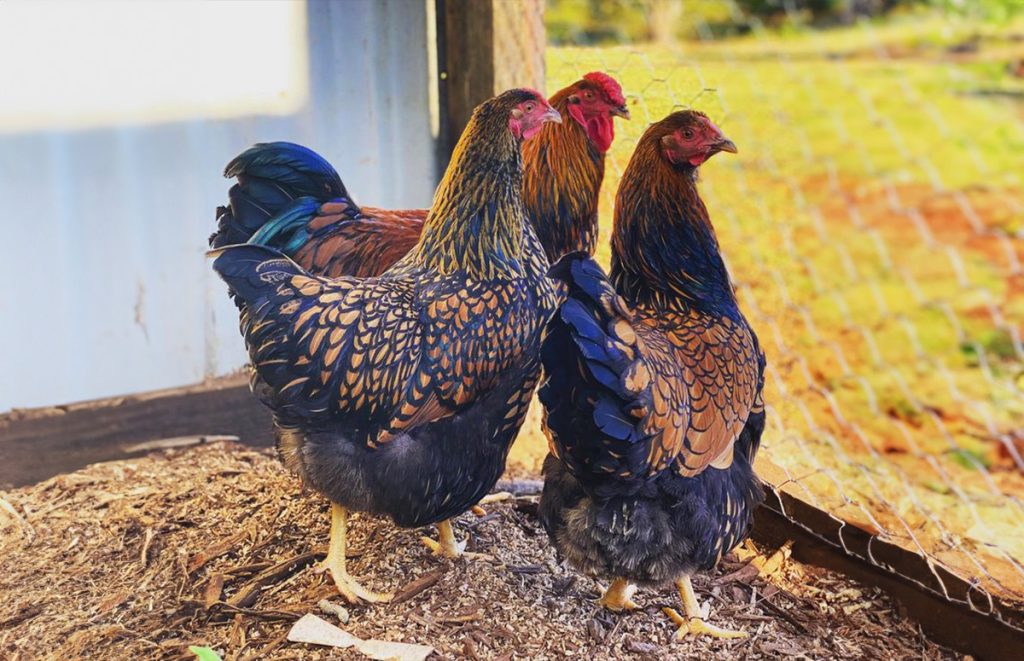
The naming of all the color varieties of Wyandottes can be very confusing due to the (lack of appropriate) naming conventions.
While Golden Laced Wyandottes have a brown base color, Silver Laced Wyandottes feature white bodies. Logical.
But the Blue Laced variant has no blue or grey body: only the lacing is blue. So it’s similar to a Golden Laced Wyandotte but with greyish-blue lacing instead of black lacing. Here is what that looks like on a mahony brown ground color in what’s called a Blue Laced Red Wyandotte:
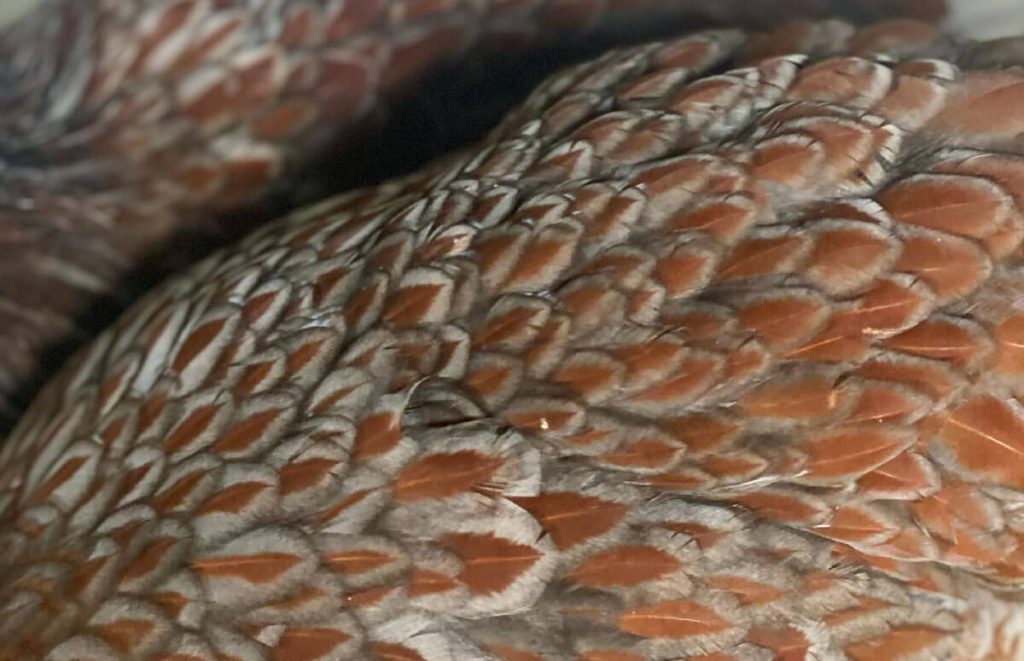
If we go further down this rabbit hole, there is also the Splash Laced Red Wyandotte. This variety resembles the Golden Laced Silver Wyandotte, but these birds have two copies of the Blue-gen, which fades the black lacing into – almost – white.
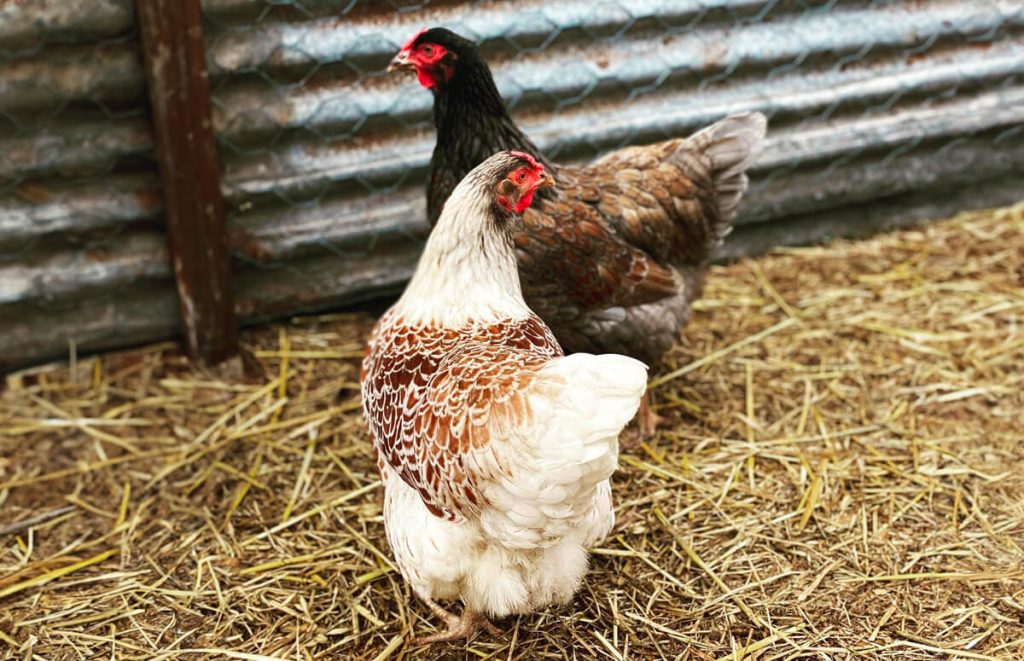
Last, the Golden Pencilled Wyandotte has black lacing like the Golden Laced Wyandotte, but it has multiple nested lines instead of the single lacing of the Golden Laced Wyandotte. This results in an entirely different color pattern.
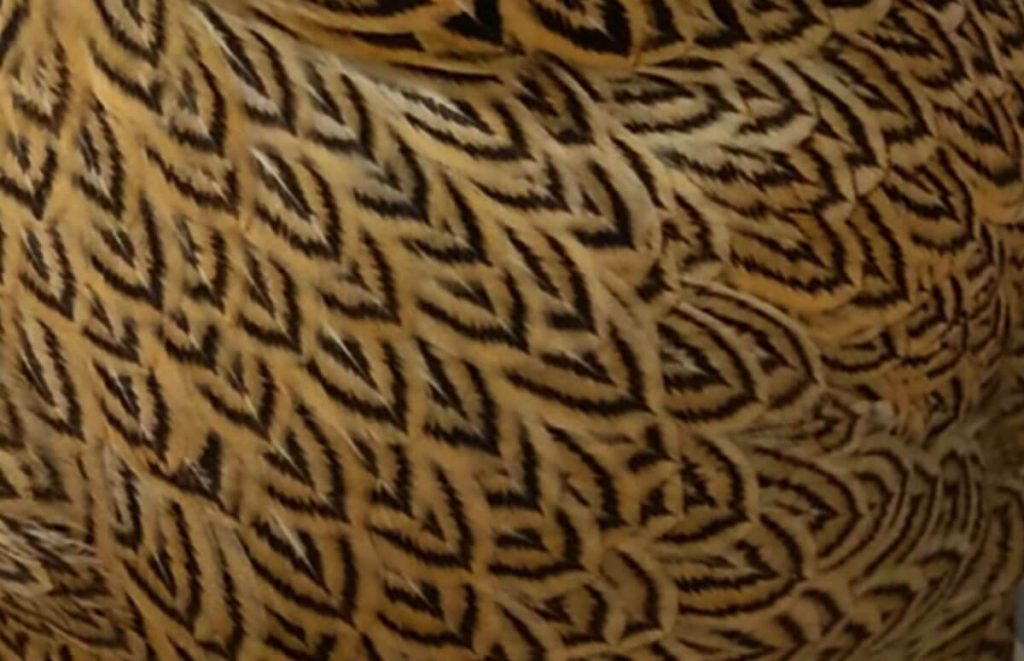
If you zoom in on the picture, you can see that the rims of the feathers aren’t black either: the penciling is only on the inside of the feather. In comparison, the Golden Laced Wyandotte has its black lacing on the outside of the feathers. This is due to genetics, as we’ll discuss later.
History of the Golden Laced Wyandotte
The Wyandotte was developed in the United States during the 1870s, and owes its creation to the collaboration of four breeders: H. M. Doubleday, John Ray, L. Whittaker, and Fred Houdlette. The first recognized color variation was the Silver Laced Wyandotte, acknowledged in the American Standard of Perfection in 1883.
The exact origin of the Wyandotte remains unknown, but it’s believed the Dark Brahma and Spangled Hamburg were involved. Its name was originally American Sebright or Sebright Cochin. They were later renamed ‘Wyandotte’ after a once numerous North American native tribe.
After the Silver Laced color variety was created, the Golden Laced Wyandotte was produced by breeding these Silver Laced hens with Gold-Spangled Hamburg and Partridge Cochin roosters. The Hamburg’s contribution is seen in the breed’s rose comb, making them well suited for colder climates.
At least, that’s what the British poultry standards tell us. According to Edgar L. Petty, the Golden Laced Wyandotte was created in 1880 by Joseph McKeen from a Silver Laced Wyandotte. He crossed Silver Laced Wyandotte females with a breed known as the Winnebago, a 19th-century American chicken breed of unknown origin that exhibited the Black Red pattern.
Golden Laced Genetics
The pattern of the Golden Laced Wyandotte is the result of two effects:
- the golden brown ground color
- the black lacing
The black lacing does not result from a single gene but originates from the intricate interplay of multiple genes that shift the black pigment in the feather:
- Pattern Gene (Pg): this pattern gene creates several lines; however, Pg on its own creates concentric penciling, and the rim of the feather would not be black
- Melanotic (Ml): this gene makes the lines wider and shifts them toward the edge of the feather
- Columbian (Co): this gene removes the inner laces and creates single-lacing
Breeding the Golden Laced Wyandotte
Golden lacing was the second color ever on Wyandottes and is still common among breeders today.
One of the advantages is that Golden Laced Wyandottes breed true. If you cross a Golden Laced Hen and Golden Laced Rooster, the offspring is also Golden Laced. This is not the case for other variants, like the Blue Laced Red, as the blue gene does not breed true.
Breeding Challenges
Laced Wyandottes are popular at exhibitions where breeders and judges frequently discuss the birds standing beside the cages. But while there are many breeders, they are relatively infrequently showcased, as it’s so difficult to get the color balance and lacing perfect.
Getting the typical curved stripes and feather roundness can be difficult due to a harder and somewhat longer feather structure. Oftentimes, several breeding cycles are needed to get a uniform and beautiful lacing around the inner field of the feather.
Breeders of Golden Laced Wyandottes also face challenges in balancing the gold color. Too light and an unwanted grain appears; too dark and the animals resemble mahogany, making the overall appearance too dark.
Golden Laced Wyandotte x Silver Laced Wyandotte Crosses
When you crossbreed Golden Laced Wyandottes with Silver Laced ones, the results are influenced by the silver gene. Birds without the Silver gene look gold. It’s the original wild-type color of a chicken. The Silver gene makes the ground color white.
The silver gene is sex-linked on the Z chromosome of a chicken. Roosters have two Z-chromosomes (ZZ), and hens only have one (ZW). Silver (S) is dominant over gold (s+), so if a Rooster has a single copy of Silver (S s+), its plumage is white.
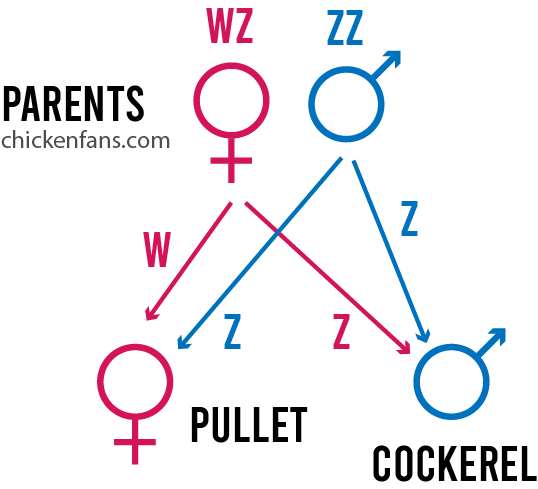
So, if you have a Silver Laced Wyandotte Rooster, it can be carrying Gold (Ss+), and the offspring can be Gold Laced Wyandottes. Both males and females.
The following table gives an overview of the possible crosses of a Golden Laced Wyandotte with a Silver Laced Wyandotte:
| Rooster | Hen | Rooster Offspring | Hen Offspring |
|---|---|---|---|
| Golden Laced (s+s+) | Silver Laced (S-) | Silver Laced (Ss+) | Golden Laced (s+-) |
| Silver Laced (SS) | Golden Laced (s+-) | Silver Laced (Ss+) * | Silver Laced (S-) |
| Silver Laced carrying Gold (Ss+) | Golden Laced (s+-) | Silver Laced (Ss+) * Golden Laced (s+s+) | Silver Laced (S-) Golden Laced (s+-) |
| Silver Laced carrying Gold (Ss+) | Silver Laced (S-) | Silver Laced (SS) Silver Laced (Ss+) * | Silver Laced (S-) Golden Laced (s+-) |
One remark here is that Silver (S) is incompletely dominant to wild type (s+). The Silver gene, on its own, allows some expression of red pigments, especially in the breast and shoulders. This shows up as yellow or buff instead of white. The amount of yellow depends on modifying genes, so it depends on the DNA of your bird.
If you cross a Silver Laced Wyandotte with other color varieties besides the Gold Laced, you will get an interplay of the different genes.
Adding the Blue gen into the mix will dilute the black lacing to blue or splash. The offspring will have all kinds of colors. This can get you closer to the Blue Laced Red Wyandotte.
Personality
Golden Laced Wyandottes typically have a gentle and docile personality, as is true for all Wyandotte varieties. They are friendly towards humans and children. Although they look nice, they are a little too big to be lap chickens.
They are also friendly towards other chickens but can be a little dominant when mixed with smaller breeds. Wyandotte hens are then likely to become the alphas of the flock, high in the pecking order.
Other Reads
Here are some of the articles we mentioned:
- Wyandotte Chickens: an overview of the Wyandotte chicken breed and the color varieties
- Silver Laced Wyandotte: a breed profile of the Silver Wyandotte variety
- Silver Penciled Wyandotte: a breed profile of the Silver Penciled Wyandotte variety
- Blue Laced Red Wyandotte: a comprehensive guide on this interesting variety
- Blue Wyandotte: a complete guide of the Blue Wyandotte chicken and blue varieties
- Buff Wyandotte: a complete guide of the Buff Wyandotte chicken and buff varieties
- Splash Laced Red Wyandotte: a guide on the Splash Laced Red variety
- Columbian Wyandotte: a striking black and white variety of the Wyandotte chicken
- White Wyandotte: a breed profile of the White Wyandotte
- Sebright Chickens: a chicken breed that has varieties with a similar lacing pattern
- Brahma Chickens: large chicken breed initially used to create the Wyandotte
- Hamburg Chickens: chicken breed used to create the Wyandotte, with similar black and white patterns
- Chicken Feather Guide: to understand the difference between all types of feathers
- Chicken Breeding & Genetics: an overview for chicken breeding and genetics for beginners
If you are considering to get Silver Laced Wyandottes, here are some other resources:
- Chicken Coop Size Calculator: to calculate the size of your coop
- Chicken Raising Guide: general chicken raising guide
Credits for the photos go to Cactus Hill Poultry breeders, specializing in breeding Wyandottes.






















